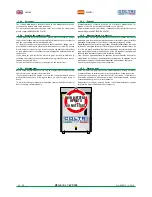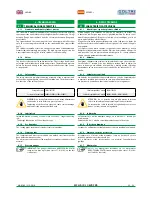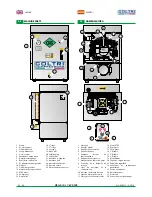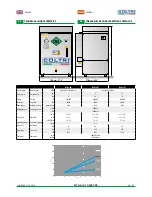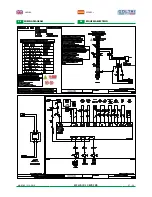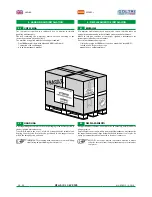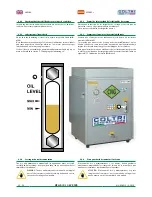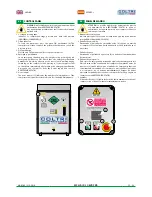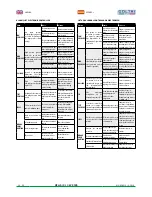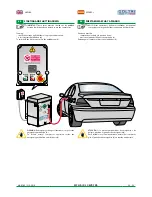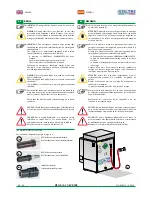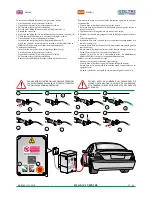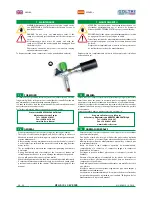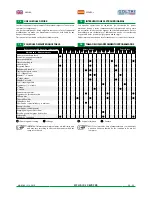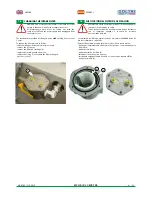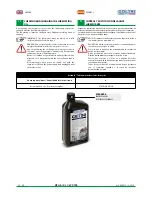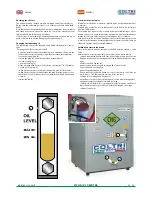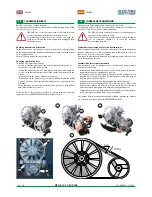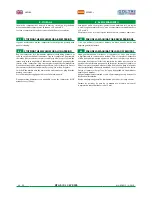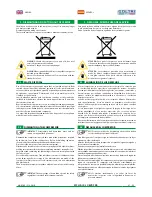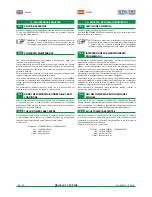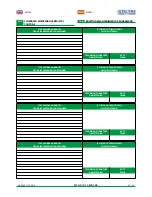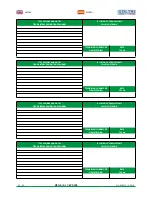
36 - 52
MCH-5-10-14 EVO CNG
MU-BCNG1014-0918
MCH 10/ET CN
G
a
TK4
TK4I
TK22
ENGLISH
6.5
REFILL
IMPORTANT: During refill the operator must be in the work
area (a).
Check that the tanks to be refilled are in good condition: they
must have been tested by the relevant authorities (stamped
and/or certified). Run a visual check on the exterior.
Check that the refill hose and relevant fitting are in good
condition.
IMPORTANT: If an emergency situation arises during refill
shut down the compressor immediately (see “6.4 Starting and
shutting down”).
The compressor is nevertheless equipped with a safety
system that shuts it down automatically when:
- A pressure of 200/250bar (2900/3626PSI) has been
reached.
- The electrical power supply is temporarily cut.
- The electric motor overload device is tripped.
Following an emergency shutdown always make sure
the cause of the emergency has been eliminated before
proceeding with another refill.
WARNING: During refill those not involved in the refill
procedure must maintain a safety distance of at least 3
metres. Also, it is forbidden to disconnect the hoses from the
fittings or the fill valve while the machine is under pressure.
WARNING: Use only tested tanks (as proven by a test stamp
and/or certificate).
The working and tank refill pressures are shown on the tanks
themselves.
It is forbidden to refill them at a pressure greater than that
indicated.
DANGER: Should tanks show evident signs of internal/extern
al corrosion, do not refill them even if they have been tested.
DANGER: Gas is highly flammable: it is therefore strictly
forbidden to smoke and/or use naked flames. Use of
equipment that can cause sparks is also strictly forbidden.
Keep the compressor away from heat sources.
The available refill connectors are:
NGV1 Car Connection: International Standard
NGV1 Car Connection: Italy Standard
Fitting for bus and trucks
ESPAÑOL
6.5
RECARGA
AVISO: Durante esta operación, el operador debe mantenerse
en el área de trabajo (a).
Compruebe las condiciones de los depósitos a llenar: Prueba
de ensayo del órgano autorizado (punzonado y/o certificado).
Control visual externo.
Compruebe las condiciones de los latiguillos y de las
conexiones correspondientes.
AVISO: Si durante la recarga se presentan condiciones de
emergencia, extinguir de inmediato el compresor (Véase “6.4
Puesta en marcha y apagado”).
El compresor está provisto de un sistema de seguridad que se
encarga de bloquearlo automáticamente cuando:
- Se ha alcanzado la presión de 200/250bar (2900/3626PSI).
- Se produce una momentánea interrupción de la corriente
eléctrica.
- Se dispara el desenganche térmico del motor eléctrico por
sobrecarga.
Después de un paro de emergencia, antes de realizar otra
recarga, es necesario asegurarse de que se ha eliminado la
causa que ha provocado la emergencia.
ATENCIÓN: Durante la recarga es obligatorio, que la personas
ajenas al trabajo se mantenga a una distancia de seguridad
superior a 3 metros. Se prohíbe desconectar los latiguillos de
las conexiones o de la llave de recarga mientras la máquina
está bajo presión.
ATENCIÓN: Utilice sólo depósitos comprobados y con el
correspondiente grabado y/o certificado de prueba de
ensayo.
El valor de presión de ejercicio y recarga de los depósitos se
indica sobre las mismas.
Se prohíbe superar dicho valor de presión de recarga.
PELIGRO: En caso de depósito que presenten evidentes signos
de corrosión interna y/o externa, se aconseja no proceder con
la recarga aunque éstas entren en los términos de prueba.
PELIGRO: El gas es altamente inflamable por lo tanto se
prohíbe fumar o usar llamas libres. Asimismo, es importante
no utilizar equipos que puedan causar chispas.
Mantener el compresor alejado de fuentes de calor.
Las conexiones disponibles para la recarga son:
NGV1 Conexión para los coches: Standard international
NGV1 Conexión para los coches: Standard Italia
Conexión para los autobús y camión

